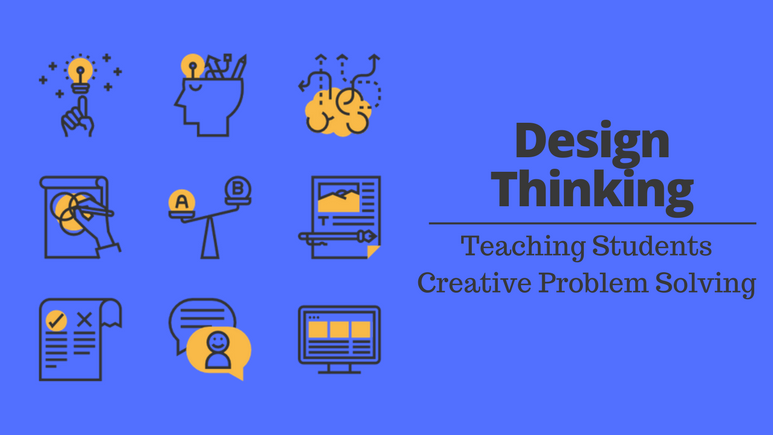
Today, many people who’ve grown accustomed to rideshare apps, such as Uber, can’t imagine going back to the days of riding in taxis.
In hindsight, taxis seem incredibly inconvenient to many. You have to stand on a street corner to find one, drivers prefer you to pay in cash, and you have no way of knowing if they are trustworthy before getting into their car.
The founders of Uber identified these problems and came up with a solution to address them. Ride share apps have gone through many iterations and continue to adapt to user feedback and needs, now with more options than ever.
There’s a name for this problem-solving process of inventing, testing, revising, and reinventing, and the process is also finding a place in classrooms across the country as a problem-solving protocol for students.
It’s called Design Thinking and it has great potential to help students solve problems in a new way.
What is Design Thinking?
One of the downsides to engaging students in creative and open-ended problems in the classroom is that such projects can sometimes lack organization and structure.
Design thinking provides a structure through which students can solve a problem or approach creative work.
Students start with an issue that they want to tackle. This could be anything from a problem they’ve seen in their school such as bullying, or an issue facing society such as pollution. The possibilities are endless!
Then, students work their way through the five steps of the design process in order to better understand the problem, design a solution to it, and then improve upon their original idea.
The 5 Steps of Design Thinking
- The first step? Empathizing. In this stage, students will seek to better understand the problem they are trying to solve. They’ll interview people who face the problem every day, do research on the issue, and come to better understand the root causes.
- Next, students will use the information they gathered in the empathizing phase to clearly define the problem they want to solve. Often times teams will realize that they now have a new or more specific idea of what they want to focus on.
- Thirdly, it’s time to ideate by coming up with as many ideas as possible for how the problem could be addressed. What’s important here is convincing students not to filter themselves. All ideas are valid and the process is much more productive if students let their imaginations run wild.
- From there, students sort through all of their ideas and develop what they think is the most promising. In the prototype stage, kids have the chance to create a scaled down version of their idea.
- Once the prototype is ready, students will need to test it with their target audience. Usually, this will include the original people that shared their experience of the problem in the emphasizing phase.
At this point, students would ideally go back and make adjustments to their prototype based on the feedback they received.
Through this process of ideating, prototyping, testing, and revising, design thinkers come up with valid and feasible solutions to real world problems. In the classroom, this helps students tackle big questions in a focused and approachable way.
So just how can this problem-solving protocol be implemented in a classroom? Here are some tips to help you get started.
Tips for Implementing Design Thinking in Your Classroom
Show kids examples. There are plenty of videos on youtube that show the design thinking process in action in classrooms. Here’s an example of first graders using the process in science class. Find an age appropriate video to show your students, to give them an idea of what design thinking looks like.
Choose engaging problems to tackle. If you start with issues kids care about, buy-in will happen automatically.
Prepare materials. Depending on your chosen problem and how you approach design thinking will determine what materials you need. The most common staple? Post-it notes. Having students write down their ideas during the ideate step on post-its makes it easier to group, organize, and see patterns in their ideas.
Get students into their communities. Help students identify people in their school or local community they can interview while working on the empathizing stage. Conducting outside of the classroom interviews right off the bat will make the problem students are trying to tackle feel more real.
Organize peer feedback. Plan opportunities for students to give peer feedback to one another. Allowing students to give and receive feedback will increase the quality of your final products.
Plan a calendar. One of the challenges of implementing design thinking in the classroom is knowing how much time to spend. Generally, teachers have found success giving students 2 class periods per stage with a few additional days built in throughout the process for peer feedback.
Have students present work. By the end of the process, your students will be proud of what they’ve accomplished and eager to show it off. Plan a chance for them to share their solutions and get ready to be blown away.
Who knows, they may even come up with a feasible solution to a problem that genuinely needs solving!



Nice article.
I will put your “The 5 Steps of Design Thinking description” on one of my flash cards.
I think you and I are both looking for improving and helping other with learning curves.
As far as I can see, you are a startup, and your domain name is great. (You probably acquired it at an early stage of the internet.) (I hope I am not incorrect on these points)
Your articles (not only this one) are quite interesting.
I came upon them because i am trying to develop an online flash card system. I might (or might not, still have to decide) be interested in collaborating with other people.
I am going to try to connect with you on LinkedIn.
Thanks for your insights.